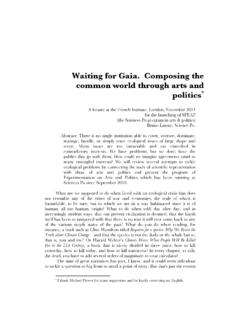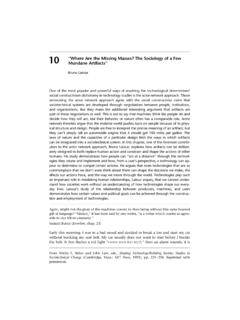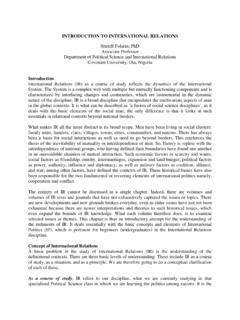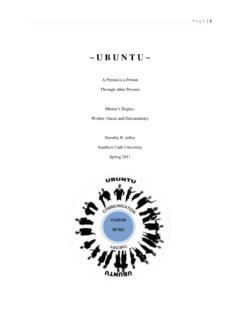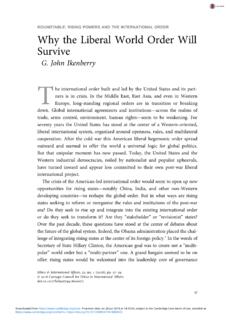Transcription of On actor-network theory. A few clarifications plus more ...
1 Bruno Latour CSI-Paris/Science Studies-San Diego in Finn Olsen (special issue of the Danish philosophy journal ), " Om aktor-netvaerksteroi. Nogle fa afklaringer og mere end nogle fa forviklinger" Philosophia, Vol. 25 N 3 et 4, ; (article crit en article written in 1990]. version anglaise (English version) in Soziale Welt, vol. 47, pp. 369-381, 1996. - version anglaise sur le web web dition Abstract : Three resources have been developped over the ages to deal with agencies. The first one is to attribute to them naturality and to link them with nature. The second one is to grant them sociality and to tie them with the social fabric.)
2 The third one is to consider them as a semiotic construction and to relate agency with the building of meaning. The originality of science studies comes from the impossibility of clearly differentiating those three resources. Microbes, neutrinos of DNA are at the same time natural, social and discourse. They are real, human and semiotic entities in the same breath. The article explores the consequence of this peculiar situation which has not been underlined before science studies forced us to retie the links between these three resources. The actor-network theory developped by Callon and his colleagues is an attempt to invent a vocabulary to deal with this new situation.
3 The article reviews those difficulties and tries ot overcome them by showing how they may be used to account for the consturction of entities, that is for the attribution of nature, society and meaning. On actor-network theory . A few clarifications plus more than a few complications P-67 On actor-network theory 2 Exploring the properties of actor-networks is the task that the Paris group of science and technology studies has set itself to tackle. However this theory (see Callon, Law, Rip 1986 for a presentation; Callon 1990 for an update) has been often misunderstoond and hence much abused. I would like in this paper to list some of the interesting properties of networks and to explain some of the misunderstandings that have arisen.
4 I will not concern myself here with the quantitative studies especially the so called co-word analysis since they are themselves misunderstood because of the difficulty of exactly grasping the social theory and quaint ontology entailed by actor-network (but see Callon, Courtial, Lavergne 1990). Three misunderstandings are due to comon usages of the word network itself and the connotations they imply. The first mistake would be to give it a common technical meaning in the sense of a sewage, or train, or subway, or telephone network . Recent technologies have often the character of a network, that is, of exclusively related yet very distant element with the circulation between nodes being made compulsory through a set of rigorous paths giving to a few nodes a strategic character.
5 Nothing is more intensely connected, more distant, more compulsory and more strategically organized than a computer network. Such is not however the basic metaphor of an actor-network . A technical network in the engineer s sense is only one of the possible final and stabilized state of an actor-network . An actor-network may lack all the characteristics of a technical network -it may be local, it may have no compulsory paths, no strategically positioned nodes. Tom Hughes s networks of power (198-), to give a historical example, are actor-networks at the beginning of the story and only some of their stabilized elements end up to be networks in the engineer s sense, that is the electrical grid.
6 Even at this later stage the engineering definition of networks are still a partial projection of an actor-network . The second misunderstanding is easy to lift: the actor-network theory (hence AT) has very little to do with the study of social networks. These studies no matter how interesting concerns themselves with the social relations of individual human actors -their frequency, distribution, homogeneity, proximity. It was devised as a reaction to the often too global concepts like those of institutions, organizations, states and nations, adding to them more realistic and smaller set of associations. Although AT shares this distrust for such vague all encompassing sociological terms it aims at describing also the very nature of societies.
7 But to do so it does not limit itself to human individual actors but extend the word actor -or actant- to non-human, non individual entities. Whereas social network adds information on the relations of humans in a social and natural world which is left untouched by the analysis, AT aims at accounting for the very essence of societies and natures. It does not wish to add social networks to social theory but to rebuild social theory out of networks. It is as much an ontology or a metaphysics, as a sociology. Social networks will of course be included in the description but they will P-67 On actor-network theory 3 have no privilege nor prominence (and very few of their quantitative tools have been deemed reusable(?))
8 Why then use the word network since it is opened to such misunderstandings? The use of the word comes from Diderot. The word r seau was used from the beginning by Diderot to describe matter and bodies in order to avoid the Cartesian divide between matter and spirit. etc Finally, the origin of the word ( r seau in French) comes from Diderot s work and has from the beginnign a strong ontological component. (see Waddington) . Put too simply AT is a change of methaphors to describe essences: instead of surfaces one gets filaments (or rhyzomes in Deleuze s parlance 197-). More precisely it is a change of topology. Instead of thinking in terms of surfaces -two dimension- or spheres -three dimension- one is asked to think in terms of nodes that have as many dimensions as they have connections.
9 As a first approximation, the AT claims that modern societies cannot be described without recognizing them as having a fibrous, thread-like, wiry, stringy, ropy, capillary character that is never captured by the notions of levels, layers, territories, spheres, categories, structure, systems. It aims at explaining the effects accounted for by those traditional words without having to buy the ontology, topology and politics that goes with them. AT has been developped by students of science and technology and their claim is that it is utterly impossible to understand what holds the society together without reinjecting in its fabric the facts manufactured by natural and social sciences and the artefacts designed by engineers.
10 As a second approximation, AT is thus the claim that the only way to achieve this reinjection of the things into our understanding of the social fabrics is through a network-like ontology and social theory . To remain at this very intuitive level, AT is a simple material resistance argument. Strenght does not come from concentration, purity and unity, but from dissemination, heterogeneity and the careful plaiting of weak ties. This feeling that resistance, obduracy and sturdiness is more easily achieved through netting, lacing, weaving, twisting, of ties that are weak by themselves, and that each tie, no matter how strong, is itself woven out of still weaker threads, permeates for instance Foucault s analysis of micro-powers as well as recent sociology of technology.
